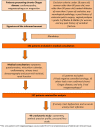Lower urinary tract dysfunction in chronic Chagas disease: clinical and urodynamic presentation
- PMID: 30302592
- PMCID: PMC6620250
- DOI: 10.1007/s00345-018-2512-3
Lower urinary tract dysfunction in chronic Chagas disease: clinical and urodynamic presentation
Abstract
Purpose: To describe and give an estimation of the prevalence of urinary disorders in chronic Chagas disease, since most clinical research has been centered on the description of the cardiac and digestive forms.
Methods: To explore this topic, a cross-sectional study was conducted in 137 Bolivian adults of both sexes suffering from symptomatic chronic Chagas disease. All patients presenting confirmed chagasic cardiomyopathy, megacolon or both underwent a urologic symptom questionnaire, uroflowmetry, urinary tract ultrasonography and a creatinine assay. When urinary abnormality was detected, a complete urodynamic study was proposed including cystometry, pressure-flow studies and urethral pressure profile.
Results: Out of all study patients, 35 (26%) had a Chagas cardiomyopathy, 81 (59%) a megacolon, and 21 (15%) a megacolon associated with cardiomyopathy. In all, 63% presented urinary disorders defined by IPSS > 7 and/or ICIQ SF > 1. Among them, 62% were incontinent, mainly by bladder overactivity, and 45% presented grade 2 or 3 renal insufficiency. Of 49 patients, the urodynamic study identified 34 patients with detrusor overactivity (69%), mostly in those with Chagas megacolon. Median bladder functional capacity, urethral closure pressure and bladder compliance had normal values. Moreover, 36% of these patients presented moderate hypocontractility, without significant post-void residual.
Conclusions: This study evidenced lower urinary tract dysfunction in a majority of chronic chagasic patients; those presenting megacolon were more likely to suffer from urinary incontinence. These results strongly suggest including routine urological clinical investigation in chronic Chagas patients, as urinary incontinence due to overactive bladder is frequently observed in this population.
Keywords: Bladder; Chronic Chagas disease; Lower urinary tract; Neurogenic bladder; Trypanosoma cruzi; Urodynamic.
Conflict of interest statement
The authors declare that they have no conflict of interest.
Figures
Similar articles
-
Is sensory urgency part of the same spectrum of bladder dysfunction as detrusor overactivity?Int Urogynecol J Pelvic Floor Dysfunct. 2007 Feb;18(2):123-8. doi: 10.1007/s00192-006-0165-z. Epub 2006 Jul 6. Int Urogynecol J Pelvic Floor Dysfunct. 2007. PMID: 16823541
-
Lower urinary tract dysfunction in type 1 familial amyloidotic polyneuropathy in Kumamoto, Japan.Int J Urol. 2006 Dec;13(12):1475-8. doi: 10.1111/j.1442-2042.2006.01652.x. Int J Urol. 2006. PMID: 17118020
-
[Recommendations for the urodynamic examination in the investigation of non-neurological female urinary incontinence].Prog Urol. 2007 Nov;17(6 Suppl 2):1264-84. Prog Urol. 2007. PMID: 18214138 Review. French.
-
Urodynamic assessment of bladder and urethral function among men with lower urinary tract symptoms after radical prostatectomy: A comparison between men with and without urinary incontinence.Korean J Urol. 2015 Dec;56(12):803-10. doi: 10.4111/kju.2015.56.12.803. Epub 2015 Nov 26. Korean J Urol. 2015. PMID: 26682020 Free PMC article.
-
The burden of Chagas disease: estimates and challenges.Glob Heart. 2015 Sep;10(3):139-44. doi: 10.1016/j.gheart.2015.06.001. Glob Heart. 2015. PMID: 26407508 Review.
Cited by
-
Trypanosoma cruzi Central Nervous System Infection-Pathogenesis, Clinical Manifestations, Diagnosis, and Treatment.Curr Trop Med Rep. 2023 Dec;10(4):186-198. doi: 10.1007/s40475-023-00300-0. Epub 2023 Nov 23. Curr Trop Med Rep. 2023. PMID: 38983718 Free PMC article.
-
Clinical Effect of Acupuncture Combined with Traditional Chinese Medicine Application on the Treatment of Functional Dyspepsia in Children and the Influence on Serum 5-HT and NO Levels.Comput Intell Neurosci. 2022 Mar 31;2022:6800662. doi: 10.1155/2022/6800662. eCollection 2022. Comput Intell Neurosci. 2022. Retraction in: Comput Intell Neurosci. 2022 Dec 18;2022:9875174. doi: 10.1155/2022/9875174. PMID: 35401711 Free PMC article. Retracted.
-
Gastrointestinal Manifestations of Chagas Disease: A Systematic Review with Meta-Analysis.Am J Trop Med Hyg. 2023 Dec 4;110(1):10-19. doi: 10.4269/ajtmh.23-0323. Print 2024 Jan 3. Am J Trop Med Hyg. 2023. PMID: 38052078 Free PMC article.
-
Kidney complications of parasitic diseases.Nat Rev Nephrol. 2022 Jun;18(6):396-406. doi: 10.1038/s41581-022-00558-z. Epub 2022 Mar 28. Nat Rev Nephrol. 2022. PMID: 35347315 Review.
-
Noninvasive Biological Samples to Detect and Diagnose Infections due to Trypanosomatidae Parasites: A Systematic Review and Meta-Analysis.Int J Mol Sci. 2020 Feb 29;21(5):1684. doi: 10.3390/ijms21051684. Int J Mol Sci. 2020. PMID: 32121441 Free PMC article.
References
-
- Scremin L, Corbett C, Laurenti M, et al. T. cruzi induces megabladder in experimental Chagas disease. Parasitol Int. 1998;47(Supplement 1):200. doi: 10.1016/S1383-5769(98)80520-5. - DOI
MeSH terms
LinkOut - more resources
Full Text Sources
Medical



